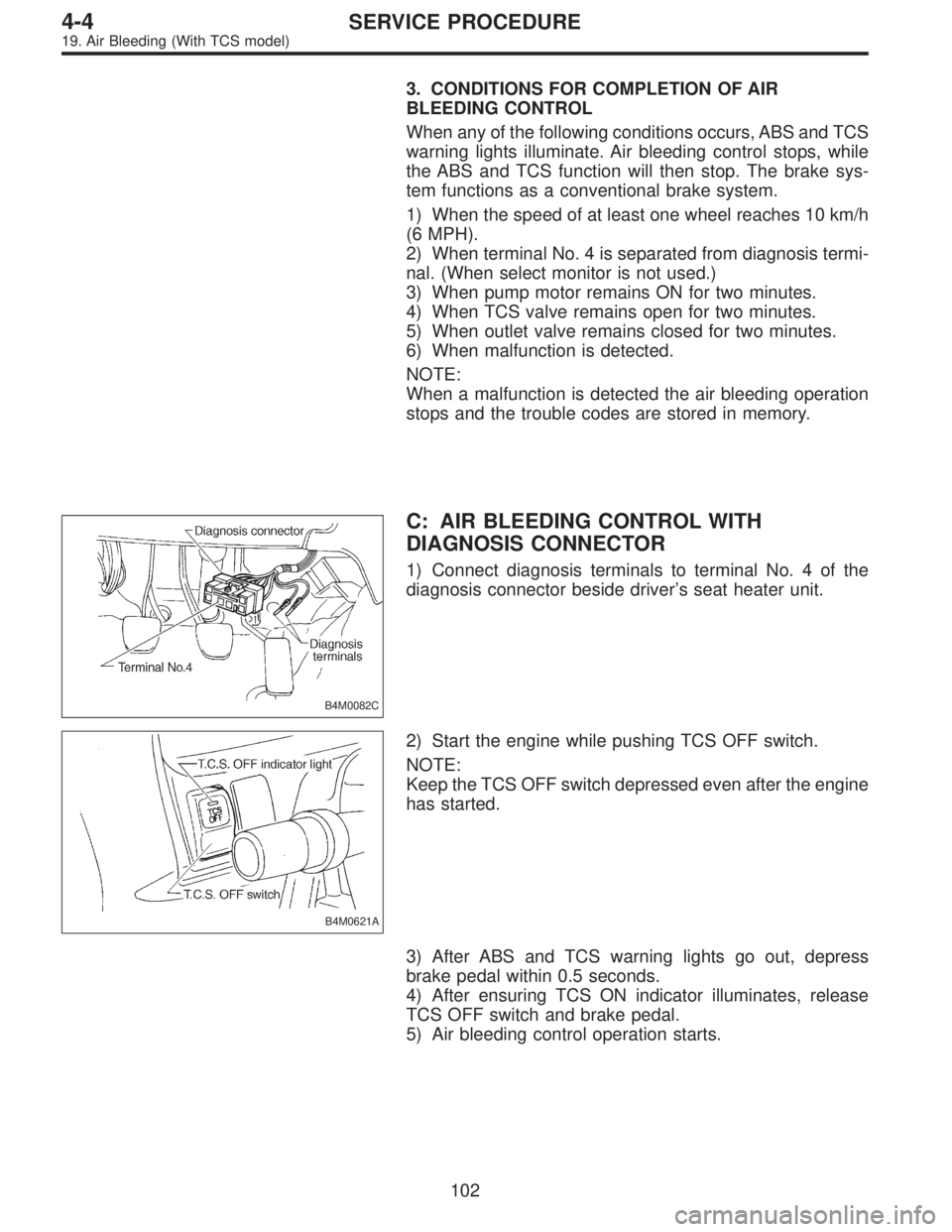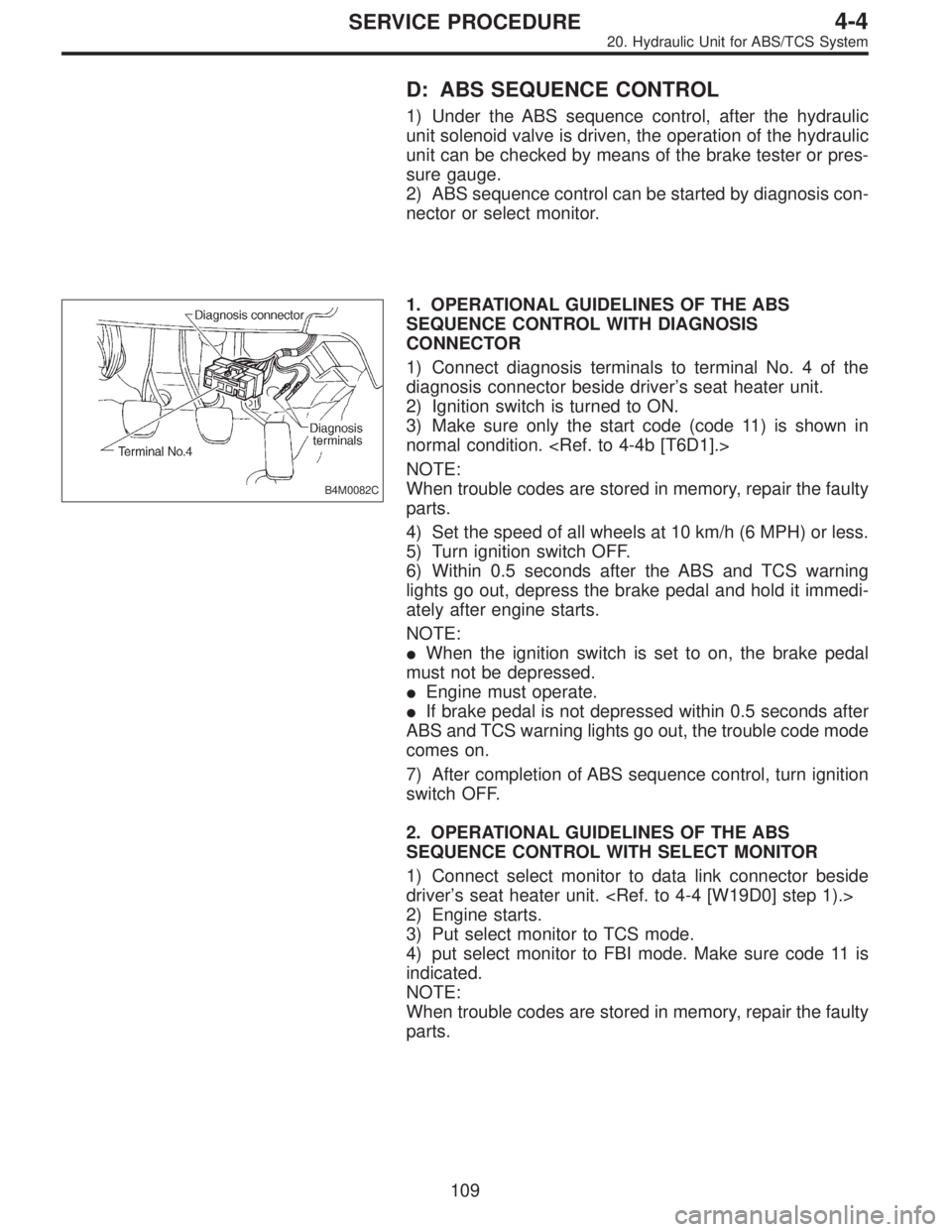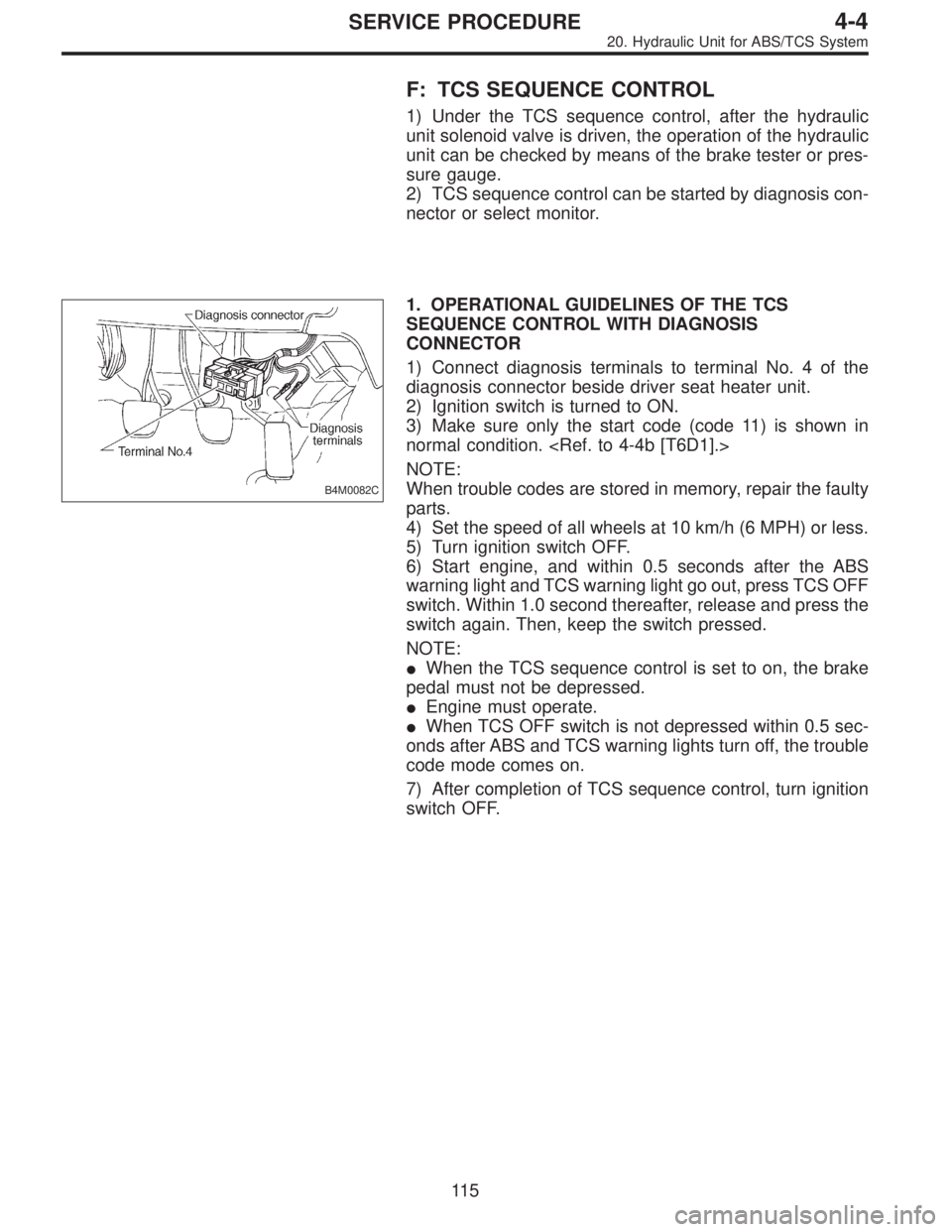Page 47 of 3342
BRAKES
[ABS
5
.31
TYPE]
[T7A3]
4-4d
7
.
Diagnostics
Chart
for
ABS
Warning
Light
Circuit
and
Diagnosis
Circuit
Failure
B1
2345
678910
1112
1
13
1
14
1
15
1
16
1
17
1
18
1
19
.
)
D
V
-
B4M1273A
I7A1
ICHONECK
IF
OTHER
WARNING
LIGHTS
TURN
Turn
ignition
switch
to
ON
(engine
OFF)
.
CHECK
:
Do
other
warning
lights
turn
on?
,rES
:
Go
to
step
7A2
.
No
:
Repair
combination
meter
.
7A2
I
CHECK
ABS
WARNING
LIGHT
BULB
.
1)
Turn
ignition
switch
to
OFF
.
2)
Remove
combination
meter
.
3)
Remove
ABS
warning
light
bulb
from
combination
meter
.
CHECK
:
Is
ABS
warning
light
bulb
OK?
,mss
:
Go
to
step
7A3
.
No
:
Replace
ABS
warning
light
bulb
.
7A3
CHECK
BATTERY
NG
LIGHT
HARNESS
SHO
RT
OF
ABS
WARN-
1)
Disconnect
connector
(B100)
from
connector
(F2)
.
2)
Measure
voltage
between
connector
(B100)
and
chas-
sis
ground
.
Connector
&
terminal
(B100)
No
.
9
(+)
-
Chassis
ground
(
)
:
CHECK
:
Is
thevoltage
less
than
3
V?
vES
:
Go
to
step
7A4
.
No
:
Repair
warning
light
harness
.
19
Page 101 of 3342
![SUBARU LEGACY 1997 Service Repair Manual
BRAKES
[ABS
5
.31
TYPE]
[T8X5]
4-4d
8
.
Diagnostics
Chart
with
Trouble
Code
by
ABS
Warning
Light
8X1
I
CHECK
STOP
LIGHTS
COME
ON
.
Depress
the
brake
pedal
.
CHECK
:
Do
stop
lights
come
on?
,rES
SUBARU LEGACY 1997 Service Repair Manual
BRAKES
[ABS
5
.31
TYPE]
[T8X5]
4-4d
8
.
Diagnostics
Chart
with
Trouble
Code
by
ABS
Warning
Light
8X1
I
CHECK
STOP
LIGHTS
COME
ON
.
Depress
the
brake
pedal
.
CHECK
:
Do
stop
lights
come
on?
,rES](/manual-img/17/57434/w960_57434-100.png)
BRAKES
[ABS
5
.31
TYPE]
[T8X5]
4-4d
8
.
Diagnostics
Chart
with
Trouble
Code
by
ABS
Warning
Light
8X1
I
CHECK
STOP
LIGHTS
COME
ON
.
Depress
the
brake
pedal
.
CHECK
:
Do
stop
lights
come
on?
,rES
:
Go
to
step
8X2
.
No
:
Repair
stop
lights
circuit
.
I
$X2
I
CHECK
OPEN
CIRCUIT
IN
HARNESS
.
1)
Turn
ignition
switch
to
OFF
.
2)
Disconnect
connector
from
ABSCM&H/U
.
3)
Depress
brake
pedal
4)
Measure
voltage
between
ABSCM&H/U
connector
and
chassis
ground
.
Connector
&
terminal
(F49)
No
.
2
(+)
-
Chassis
ground
(-)
;
CHECK
:
Is
thevoltage
between
10
V
and
15
V?
YES
:
Go
to
step
8X3
.
No
:
Repair
harness
between
stop
light
switch
and
ABSCM&H/U
.
8X3
I
CHECK
POOR
CONTACT
IN
CONNECTORS
.
CHECK
:
Is
there
poor
contact
in
connector
between
stop
light
switch
and
ABSCM&HlU?
<
Ref
.
to
FOREWORD
[T3C1]
.*70
>
,rES
:
Repair
connector
.
No
:
Go
to
step
8X4
.
18X4
I
CHECK
ABSCM&H/U
.
1)
Connect
all
connectors
.
2)
Erase
the
memory
.
3)
Perform
inspection
mode
.
4)
Read
outthe
trouble
code
.
CHECK
:
Is
the
same
trouble
code
as
in
thecurrent
diagnosis
still
being
output?
,rES
:
Replace
ABSCM&H/U
.
No
:
Go
to
step
8X5
.
8X5
CHECK
ANY
OTHER
TROUBLE
CODES
APPEARANCE
.
CHECK
:
Are
other
trouble
codes
being
output?
Proceed
with
the
diagnosis
corresponding
to
the
trouble
code
.
No
:
A
temporary
poor
contact
.
83
Page 192 of 3342
BRAKES
[ABS
5
.3i
TYPE]
[T10AF3J
4-4d
10
.
Diagnostics
Chart
with
Select
Monitor
BLS
(F09)
0
.
00
v
B4M0973
I
BLS
(F09)
12
.
00
V
84M1265
10AF1
HECKOUTPUT
OF
STOP
I
US
G
SELECT
MONITOR
.
LIGHT
SWITCH
1)
Press
[F],
[0]
and
[9]
on
the
select
monitor
.
2)
Depress
the
brake
pedal
3)
Read
the
stop
light
switch
output
on
the
select
moni-
tor
display
.
CFIECK
:
Is
the
reading
indicated
on
monitor
display
less
than
1
.5
V?
Go
to
step
10AF2
.
No
:
Go
to
step
10AF3
.
10AF2-
I
LIGHT
SWITCH
US
I
NG
SELECT
MONITOR
.
1)
Release
the
brakepedal
.
2)
Read
the
stop
light
switch
output
on
the
select
moni-
tor
display
.
CHECK
:
Is
the
reading
indicated
on
monitor
display
between
10
V
and
15
V?
0
:
Go
to
step
10AF5
.
No
:
Go
to
step
10AF3
.
1
10AF3
I
CHECK
IF
STOPLIGHTS
COME
ON
.
Depress
the
brake
pedal
.
CHECK
:
Do
stop
lights
turn
on?
Go
to
step
10AF4
.
No
:
Repair
stop
lightscircuit
.
183
Page 1386 of 3342

3. CONDITIONS FOR COMPLETION OF AIR
BLEEDING CONTROL
When any of the following conditions occurs, ABS and TCS
warning lights illuminate. Air bleeding control stops, while
the ABS and TCS function will then stop. The brake sys-
tem functions as a conventional brake system.
1) When the speed of at least one wheel reaches 10 km/h
(6 MPH).
2) When terminal No. 4 is separated from diagnosis termi-
nal. (When select monitor is not used.)
3) When pump motor remains ON for two minutes.
4) When TCS valve remains open for two minutes.
5) When outlet valve remains closed for two minutes.
6) When malfunction is detected.
NOTE:
When a malfunction is detected the air bleeding operation
stops and the trouble codes are stored in memory.
B4M0082C
C: AIR BLEEDING CONTROL WITH
DIAGNOSIS CONNECTOR
1) Connect diagnosis terminals to terminal No. 4 of the
diagnosis connector beside driver’s seat heater unit.
B4M0621A
2) Start the engine while pushing TCS OFF switch.
NOTE:
Keep the TCS OFF switch depressed even after the engine
has started.
3) After ABS and TCS warning lights go out, depress
brake pedal within 0.5 seconds.
4) After ensuring TCS ON indicator illuminates, release
TCS OFF switch and brake pedal.
5) Air bleeding control operation starts.
102
4-4SERVICE PROCEDURE
19. Air Bleeding (With TCS model)
Page 1393 of 3342

D: ABS SEQUENCE CONTROL
1) Under the ABS sequence control, after the hydraulic
unit solenoid valve is driven, the operation of the hydraulic
unit can be checked by means of the brake tester or pres-
sure gauge.
2) ABS sequence control can be started by diagnosis con-
nector or select monitor.
B4M0082C
1. OPERATIONAL GUIDELINES OF THE ABS
SEQUENCE CONTROL WITH DIAGNOSIS
CONNECTOR
1) Connect diagnosis terminals to terminal No. 4 of the
diagnosis connector beside driver’s seat heater unit.
2) Ignition switch is turned to ON.
3) Make sure only the start code (code 11) is shown in
normal condition.
NOTE:
When trouble codes are stored in memory, repair the faulty
parts.
4) Set the speed of all wheels at 10 km/h (6 MPH) or less.
5) Turn ignition switch OFF.
6) Within 0.5 seconds after the ABS and TCS warning
lights go out, depress the brake pedal and hold it immedi-
ately after engine starts.
NOTE:
�When the ignition switch is set to on, the brake pedal
must not be depressed.
�Engine must operate.
�If brake pedal is not depressed within 0.5 seconds after
ABS and TCS warning lights go out, the trouble code mode
comes on.
7) After completion of ABS sequence control, turn ignition
switch OFF.
2. OPERATIONAL GUIDELINES OF THE ABS
SEQUENCE CONTROL WITH SELECT MONITOR
1) Connect select monitor to data link connector beside
driver’s seat heater unit.
2) Engine starts.
3) Put select monitor to TCS mode.
4) put select monitor to FBI mode. Make sure code 11 is
indicated.
NOTE:
When trouble codes are stored in memory, repair the faulty
parts.
109
4-4SERVICE PROCEDURE
20. Hydraulic Unit for ABS/TCS System
Page 1395 of 3342
3. CONDITIONS FOR COMPLETION OF ABS
SEQUENCE CONTROL
When the following conditions develop, the ABS sequence
control stops and ABS and TCS warning lights come on
while the ABS and TCS function will then stop. The brake
system functions as a conventional brake system.
1) When the speed of at least one wheel reaches 10 km/h
(6 MPH).
2) When terminal No.4 is separated from ground. (When
select monitor is not used.)
3) When the brake pedal is released during sequence con-
trol and the braking lamp switch is set to off.
4) After completion of the sequence control.
5) When malfunction is detected.
NOTE:
When malfunction has been detected and the ABS
sequence control operation has stopped, the trouble codes
are stored in memory.
111
4-4SERVICE PROCEDURE
20. Hydraulic Unit for ABS/TCS System
Page 1399 of 3342

F: TCS SEQUENCE CONTROL
1) Under the TCS sequence control, after the hydraulic
unit solenoid valve is driven, the operation of the hydraulic
unit can be checked by means of the brake tester or pres-
sure gauge.
2) TCS sequence control can be started by diagnosis con-
nector or select monitor.
B4M0082C
1. OPERATIONAL GUIDELINES OF THE TCS
SEQUENCE CONTROL WITH DIAGNOSIS
CONNECTOR
1) Connect diagnosis terminals to terminal No. 4 of the
diagnosis connector beside driver seat heater unit.
2) Ignition switch is turned to ON.
3) Make sure only the start code (code 11) is shown in
normal condition.
NOTE:
When trouble codes are stored in memory, repair the faulty
parts.
4) Set the speed of all wheels at 10 km/h (6 MPH) or less.
5) Turn ignition switch OFF.
6) Start engine, and within 0.5 seconds after the ABS
warning light and TCS warning light go out, press TCS OFF
switch. Within 1.0 second thereafter, release and press the
switch again. Then, keep the switch pressed.
NOTE:
�When the TCS sequence control is set to on, the brake
pedal must not be depressed.
�Engine must operate.
�When TCS OFF switch is not depressed within 0.5 sec-
onds after ABS and TCS warning lights turn off, the trouble
code mode comes on.
7) After completion of TCS sequence control, turn ignition
switch OFF.
11 5
4-4SERVICE PROCEDURE
20. Hydraulic Unit for ABS/TCS System
Page 1401 of 3342
3. CONDITIONS FOR COMPLETION OF TCS
SEQUENCE CONTROL
When the following conditions develop, the TCS sequence
control stops and ABS and TCS warning lights come on
while the ABS and TCS function will then stop. The brake
system functions as a conventional brake system.
1) When the speed of at least one wheel reaches 10 km/h
(6 MPH).
2) When terminal No. 4 is separated from ground. (When
select monitor is not used.)
3) When the brake pedal is depressed during sequence
control and the braking lamp switch is set to ON.
4) When TCS OFF switch is released. (When select moni-
tor is not used.)
5) After completion of the TCS sequence control.
6) When output signal to break TCS control is emitted from
ECM.
7) When malfunction is detected.
NOTE:
When malfunction has been detected and the TCS
sequence control operation has stopped, the trouble codes
are stored in memory.
11 7
4-4SERVICE PROCEDURE
20. Hydraulic Unit for ABS/TCS System